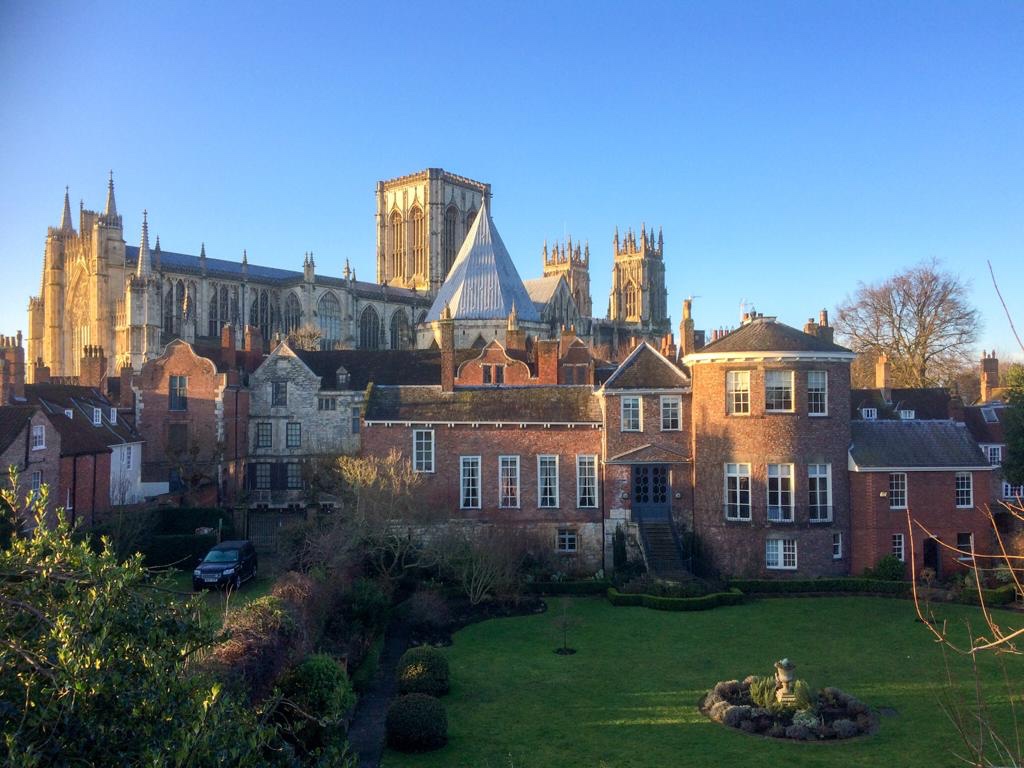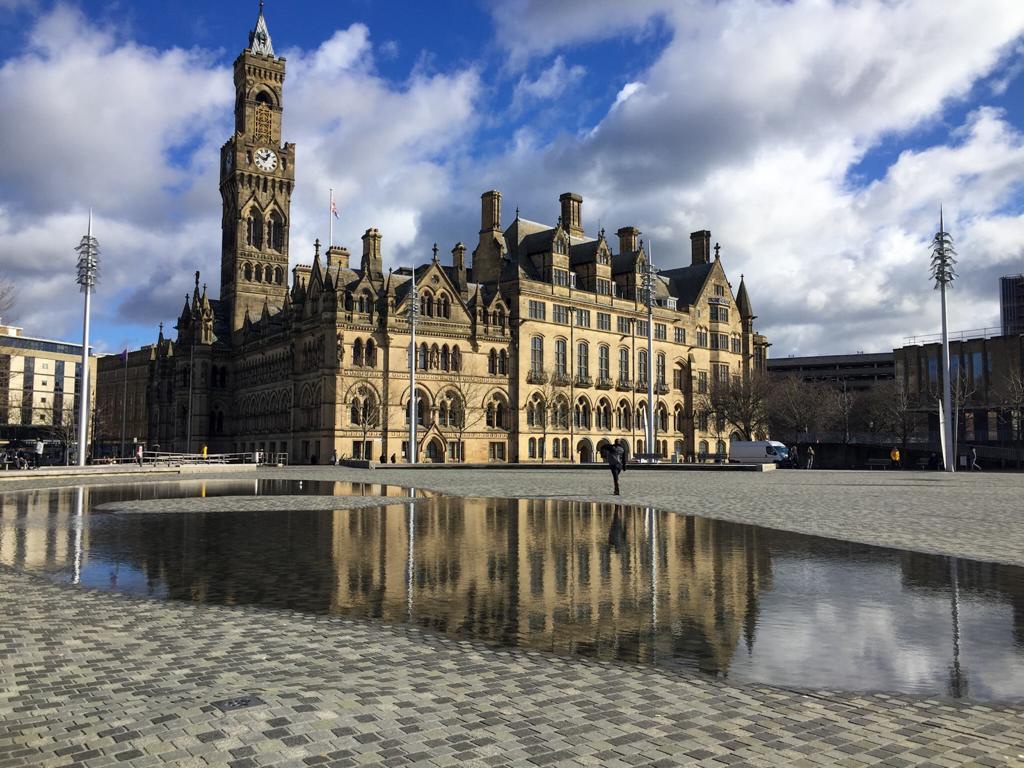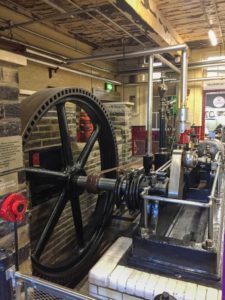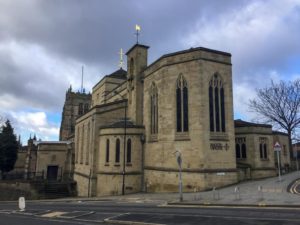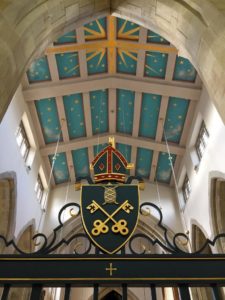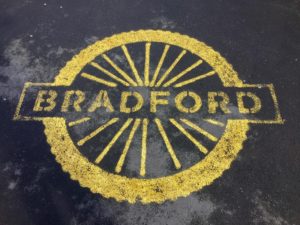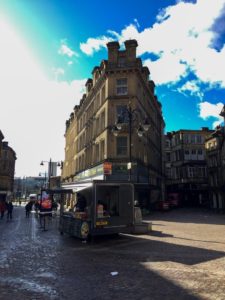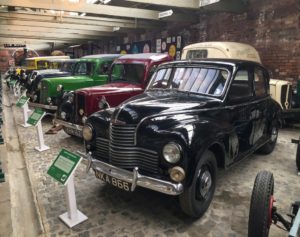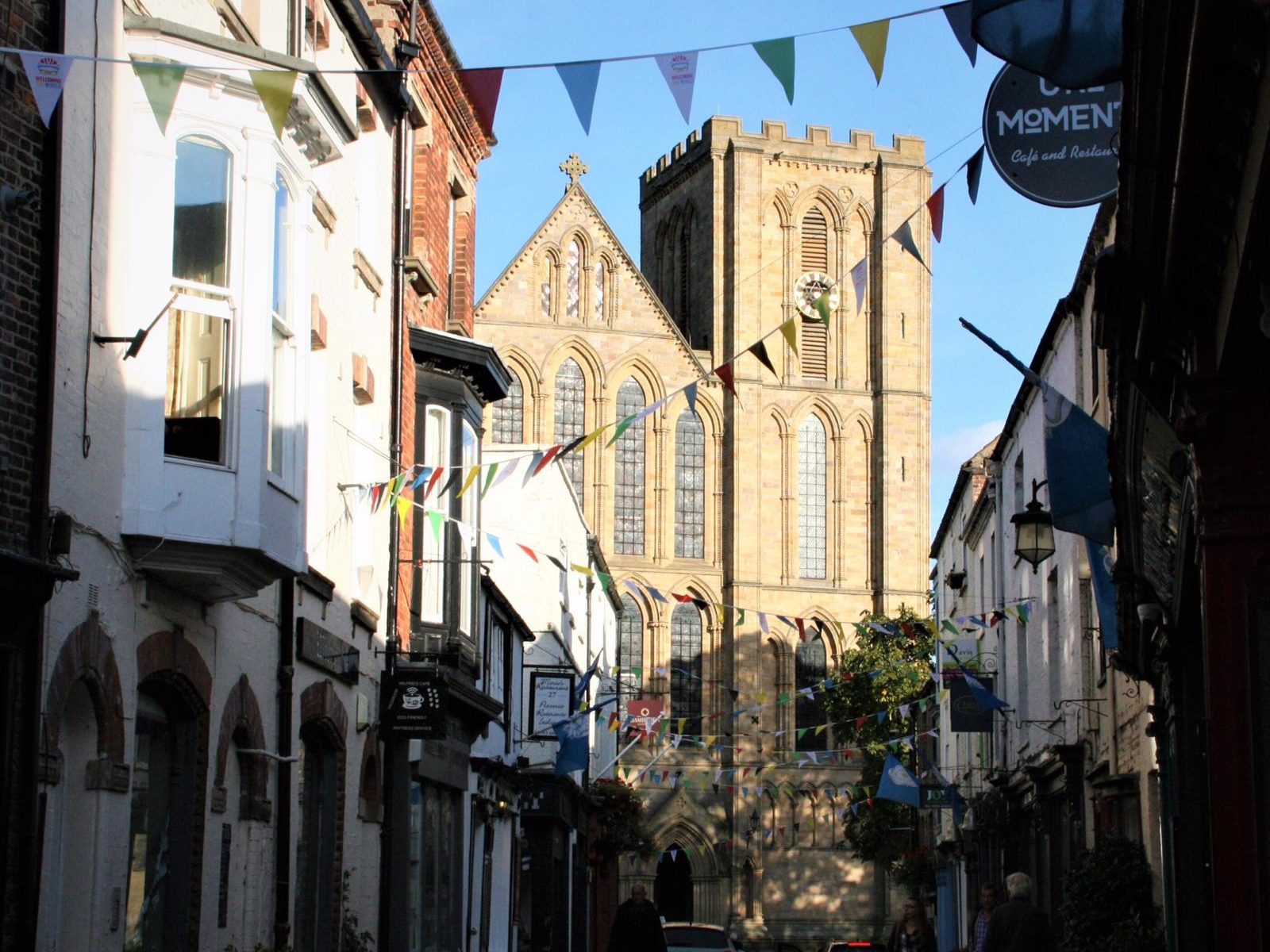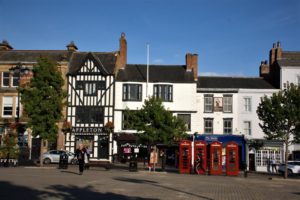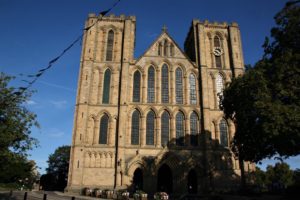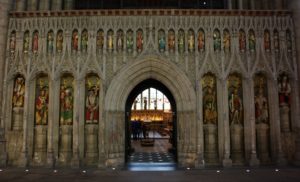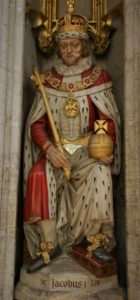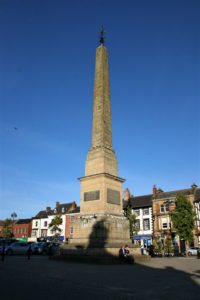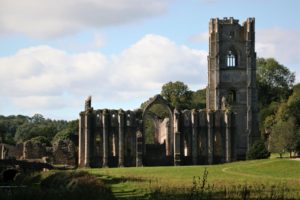There are good days and not so good days. There are early morning run days and there are other days. There are home days and away days. Today was a good day (in every sense of the word – weather, profitable, awakening, etc.), an away day and ideal for a run. I left my hotel and started running from Clifford’s Tower around the walls before finding somewhere for breakfast. In those heavy plods, my overweight body gasped at the fresh winter air and cleared my lungs; I was richly rewarded for such an early start. As the sun shone and warmed my sleepy muscles, I began to enjoy this newfound way to explore a city. I must surely look at the health and environment benefits of exploring places in this and other ways. Like many of these cities this was not a first visit, but again my memory, or lack of it, has let me down, for anyone who has been to York will remember it.
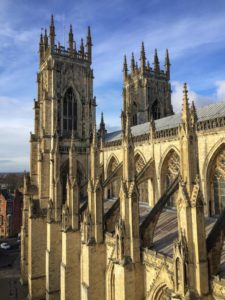
It was reportedly said by King George VI, “that the history of York is the history of England”. Whether he ever said this I will leave to those who wish to confirm or otherwise, but what I will say is that if he didn’t say it, I will! York, the capital of the north, a Christian stronghold, once Europe’s chief trading base, and England’s second city, it really does provide a snapshot of England’s history. Although not England’s second city now, it is home to an important diocese within the Church of England and the title handed to the second son of a given reigning monarch.
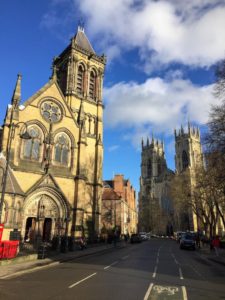
How it came to be known as York is a mystery to me. When the Romans arrived, they named it Eboracum, before the Saxons changed it to Eoforwic and the Vikings named it Jorvik. Like I’ve mentioned before the Romans had a good eye for establishing bases. York was no different. Its ideal strategic location on the conflux of the rivers Ouse and Foss was their chosen spot. It probably provided good transportation links as well as defences. Very little of Roman Britain remains in York – there is an odd pillar here and there. Rumours are that much of Roman York is buried under the city itself but it does lay claim to the place of the proclamation of the Roman Emperor Constantine (a statue dedicated to the emperor can be found outside the Minster).
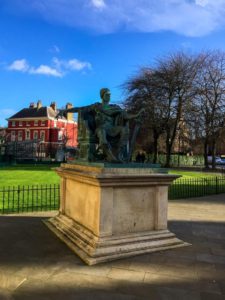
As the history books will no doubt inform me the Romans’ influence declined and then it was the turn of the Saxons and Vikings. York is filled with museums documenting their time in the city. Those not wishing to spend time in these museums only need to look at the Danish street names for the influence left over from the Vikings.
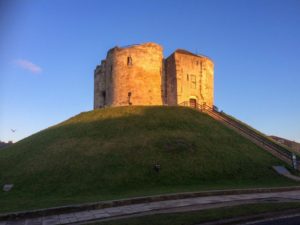
Everyone knows how the Saxon/Viking era finished some 300 miles south of York in Hastings by the Normans in 1066 – and all that. The new king of the land set about touring his newfound kingdom and building defences and religious buildings. He arrived in York relatively easily with no resistance and was handed the keys. He quickly set about building its defences as he raised a motte and baily castle here. The building of structures used for religious purposes didn’t come for another 200 years, so was there something already here? The city had two castles built and Clifford’s Tower (where my run commenced) is one of them. As I did those runs up and down the stairs to the castle I quickly got an idea of how easy it might be to defend these hills. Clifford’s Tower is the only remaining castle – the other has long gone. It is named after Roger de Clifford who was hanged here in 1322. There is a museum opposite the tower which houses the cell formerly used by highwayman Dick Turpin. These first original defences built by William weren’t that secure as the Vikings returned to capture the city. William returned, and set about rebuilding the city walls and destroying much of the land between here and Durham.
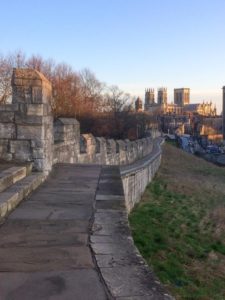
York’s other military defences that can be still seen today are its perfectly kept walls. Whoever saved the day in the 18th century when most city walls were being pulled down must be praised. What is left is not all encapsulating as I got lost when the walls stopped. Like Chester’s walls they beg to be traversed. At just over 3-mile-long they provided perfect running space and dreamy views on an early morning. I was lucky enough to get pictures of the Minster, etc. Whilst walls provide a great way of stopping anyone from coming in or out, there was a need for gates to be included. These medieval gates are called Bars. 4 of them are placed in the walls but I did not find out whether or not they match the points of the compass. Their names are Bootham, Walmgate, Monk and Micklegate. Built between the 12-15th centuries these provided the collection point for city taxes. The final two on the list of 4 are now museums to Richard III (Monk) and Henry VII (Micklegate). When I return Monk Bar must surely be in line for a visit as I’m currently reading about Richard III. Perhaps I should devote as much time to Micklegate Bar as well, as the city’s most famous of Bars. It is said that the monarch, upon arriving at York, would wait at Micklegate and seek the permission of the Lord Mayor to enter the city. Micklegate Bar was also the place in which the heads of traitors and rebels were placed on display. This gruesome decoration was prominent during the ebb and flow of the War of the Roses and as each side took an upper hand, they would display how successful it had been by this means. Most distasteful.
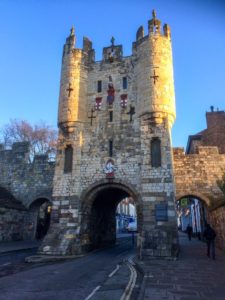
Inside those protecting walls lies the glory of York, it’s Minster. York Minster has been described as one of the world’s most magnificent cathedrals. This is up for debate. I mean, it’s not even a cathedral but a minster??? So how can it be one of the most magnificent in the world. My visits to cathedrals recently haven’t endeared me to them, substantial financial costs for entrance a major problem, but also timing my visits with essential building works. York minster was no different, at an alarming £11.50 to enter. I was heartbroken to see that the middle of the church had been blocked off for the once-in-a-century tuning of the organ thus ruining my photos of the inside and meaning access to see the central tower ceiling impossible. My selfish desires to capture everything on one visit must be put aside as I sit down and remember the cost of maintaining these buildings but also marvel at the sheer size of this place. I’ve made many a mention about how on earth these religious places were ever built or how they were designed. There is such a vacuum of empty space inside, one can certainly feel lonely.
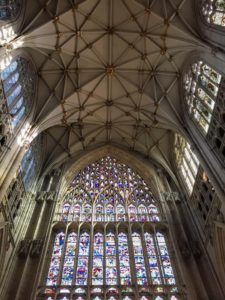
On such a beautiful day I didn’t really want to waste it on the inside, I paid an extra £5 to complete the tower tour. 275 steps later I was rewarded with the best views of the city in glorious winter sunshine and well worth the exercise. I finally dragged myself back down again and had a wander around. Did you know that the Archbishop of York is the second highest ranking clergyman in the land? I guess an archbishop comes at the top of the hierarchy in the church of England and the Archbishop of Canterbury is the top man. The sheer size of the diocese of York also means that the archbishop is kept a very busy man. A step outside to admire the outside of the building in sunshine is much more appealing on this day.
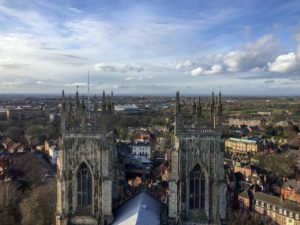
After exploring the Minster, I stepped further into the city to be amazed at its preservation. You will find medieval, Jacobean and Georgian architecture now combined with the modern landscape of a city. There is so much to explore down winding and narrow cobbled streets. One street in particular is a favourite on Instagram, ‘the Shambles’. This crooked street with beautifully preserved, over hanging timber buildings provide the must take photo of the city. How many times has this street cropped up on Instagram pages? It is argued that it is the finest medieval street in Europe, and it is hard to disagree – people in Germany and in a city like Prague might have something to say. It really does feel like a step back in time, although its current shop holders don’t resemble the originals (a street full of butchers). There are many nooks and crannies to explore in this city and an overwhelming number of churches and museums. These museums also provide light to one of the cities more modern successes. Chocolate and sweets. We’ve all heard of the names Terrys, Cravens and Rowntree.
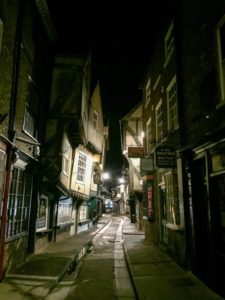
The success of these chocolatiers in the 19th Century owed much of its fortune to the links that the railway provided. We associate the railway with the industrial revolution, so it’s surprising that I mention it in connection with chocolate though this became an industry. The railway line gave it market access it could have only dreamt of. It also led to the beginning of the tourist trade that the city clearly thrives upon (second only to London on the number of visitors per year), as train loads of people arrived from around the country. At one point over 250 trains were arriving each day into the city. This of course led to the Victorians building a new railway station to manage the demand. By the end of the 19th century it was the railways and chocolate industries that were the biggest employers of the city. When in York, time must surely be made to visit the largest railway museum in the world. A former steam engine shed is now a converted home to some iconic engines – the Flying Scotsman, the Mallard, Stephenson’s Rocket to name but a few. Seeing these engines was a joy to see but felt a little dreary, for there is nothing more poetic than seeing these great machines in full working order. Visit the heritage railways and you’ll begin to appreciate what I mean.

York, perhaps ‘the capital city of the North’, whose fortunes rose and fell with its ties to the crown and church, was once England’s second city, and perhaps in some respects still is. I wish I had longer. There is so much that I still haven’t seen or learned about but as so many cities claim to be modern metropolises, York’s claim to fame is its warped beauty and it remains an ancient artefact with its history is its greatest asset. York, I long to be back and to delve deeper into your layers of history.
York, England, United Kingdom

